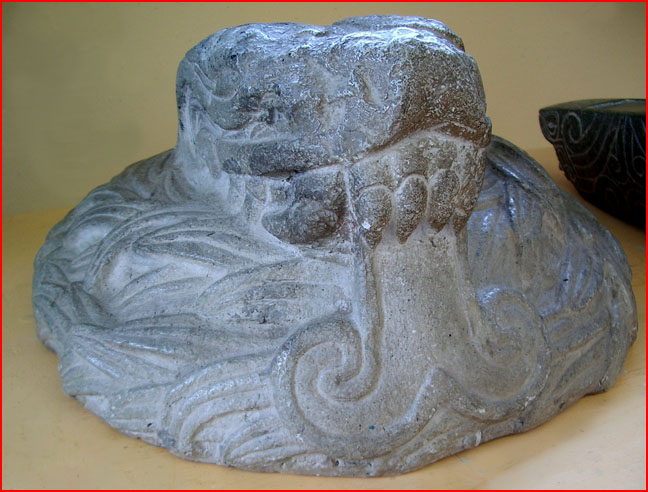
home •
about •
essential guide •
picture of the day •
thunderblogs •
news •
multimedia •
predictions •
products •
get involved •
contact
picture of the day archive subject index
Credit: Rens van der Sluijs
Nov 29, 2007
The Feathered Serpent
The luminous "feathers" of mythic serpents add an exclamation point to the unexplained patterns of world mythology. But plasma science suggests a new interpretation, one that could place serpent images as a whole in an entirely new light.The principal god of the Aztec was Quetzalcoatl, one of whose best known aspects was that of the 'feathered serpent'. The impression shown here is on display in the anthropological museum of Villahermosa in Tabasco, Mexico. The image is well known, but the oddness of a snake covered in feathers remains unexplained; needless to say, snakes have a scaly skin and the closest approximation to feathered reptilians are palaeontological findings of bird-like dinosaurs that have nothing to do with mythology.
The mystery is deepened by the fact that striking parallels are found beyond the boundaries of the Aztec world. The Maya called the plumed dragon Cuculcan or Cucumatz, the Zuñi Kolowissi, the Hopi Palulukoñ. As far South as Venezuela we hear of the snake Huiio who crowned herself with the scattered feathers of the ancestral birds, as the Makiritare people report. In Greek mythology, the heaven-spanning giant Typhon had serpents for legs and a body "all winged" or feathered, as Apollodorus reported.
A key to the solution is the serpent's intimate connection with fire. Quetzalcoatl and his counterparts were typically envisioned as glowing entities manifesting themselves in lightning or other streaks of light displayed in the sky. The many feathers therefore point to flames of fire. In the mythology of the Brulé Sioux, Uncegila was a "huge snakelike monster" along whose back ran "a crest that sparkled like dancing flames …" Fire also burned from Typhon's hundred heads, in Greek tradition. It is easy to see how such flames could metaphorically be understood as feathers. Such an interpretation will bring the serpent’s feathers into agreement with other features of the cosmic serpent, such as its long-flowing hair, beard, or other fiery emanations.
In an interdisciplinary context, the threaded texture of the dragon's countenance answers remarkably well to the filamentation of plasma. The fine, luminous strands symbolised as 'feathers' can be explained as strong filamentation displayed when plasma experiences intense electrical activity. High-energy discharge can give rise to what plasma physicists call a 'sawtooth'-formation, illustrated by the zigzag-shape seen in lightning flashes, but perhaps the spiky features of the dragon's body as well. A shock pulse operating on the upper atmospheric strata of the earth (or upon the plasma sheath of some other charged body in space) may cause "a rippling of the layer that rapidly develops into periodically spaced spike like features. These features, or 'spikes' then evolve … the shock impulse causes the generation of yet more instability spikes that themselves morph into yet more complex instability shapes." (Anthony Peratt).
At a time when the magnetic field of the earth experienced a major influx of charged particles from space, radiant plasma shapes with a heavily threaded surface might have formed that could go down in history as snake-like dragons covered in feathers. But were such forms contained within the upper atmosphere of the earth or, as others have suggested, external to the earth (though very close)? That question remains to be answered. One objective of Peratt’s work is to identify the precise placement of the formations, by comparing tens of thousands of ancient images carved on stone around the world. He believes that simple geometry, in combination with global positioning data, can settle the question.
Contributed by Rens van der Sluijs
___________________________________________________________________________Please visit our Forum
The Electric Sky and The Electric Universe available now!

|
|

|
EXECUTIVE EDITORS:
David Talbott, Wallace Thornhill
MANAGING EDITORS:
Steve Smith, Mel Acheson
CONTRIBUTING EDITORS: Michael Armstrong, Dwardu Cardona,
Ev Cochrane,
C.J. Ransom, Don Scott, Rens van der Sluijs, Ian Tresman
WEBMASTER: Brian Talbott
Copyright 2007: thunderbolts.info
![]()
home •
thunderblogs •
forum •
picture of the day •
resources •
team •
updates •
contact us

